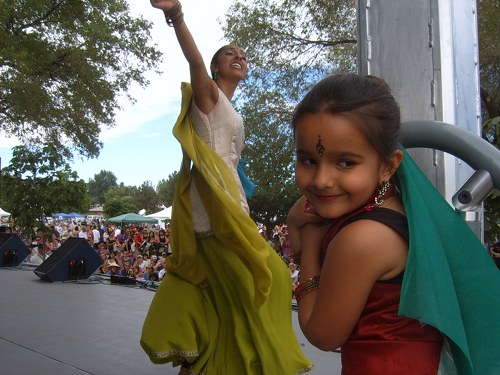November 12, 2010
Mudra Dance Studio debuts this year’s spectacular, ILLhaam
 Mudra Dance Studio has been celebrating the dynamic traditions of classical Indian dance, and putting a contemporary spin on it, since long before Bollywood films became a popular genre here in the US with non-Indians. Namita Khanna Nariani, a brilliant, energetic dynamo of a teacher and choreographer, founded the troupe 17 years ago and turned it into a non-profit organization eight years ago -- all while raising a family and maintaining a career as an architect.
We first met Namita in the second year of the Colorado Dragon Boat Festival (the photo above is from this summer's festival), and she's been a regular every year since, closing out the festival with a one-two punch of her Mudras followed by the very popular Denver Taiko Japanese drummers. Starting the third year, at Erin's suggestion, the Mudras started collaborating with Denver Taiko and now that's become a regular cross-cultural highlight of the event.
The powerful Japanese drums have come to fit so well in Namita's South Asian vision of cultural fusion, in fact, that Mudra Dance Studio now incorporates a taiko drummer, Thomas Knight, as a regular part of its exciting annual performances.
Mudra Dance Studio has been celebrating the dynamic traditions of classical Indian dance, and putting a contemporary spin on it, since long before Bollywood films became a popular genre here in the US with non-Indians. Namita Khanna Nariani, a brilliant, energetic dynamo of a teacher and choreographer, founded the troupe 17 years ago and turned it into a non-profit organization eight years ago -- all while raising a family and maintaining a career as an architect.
We first met Namita in the second year of the Colorado Dragon Boat Festival (the photo above is from this summer's festival), and she's been a regular every year since, closing out the festival with a one-two punch of her Mudras followed by the very popular Denver Taiko Japanese drummers. Starting the third year, at Erin's suggestion, the Mudras started collaborating with Denver Taiko and now that's become a regular cross-cultural highlight of the event.
The powerful Japanese drums have come to fit so well in Namita's South Asian vision of cultural fusion, in fact, that Mudra Dance Studio now incorporates a taiko drummer, Thomas Knight, as a regular part of its exciting annual performances.
 This year's performance, ILLham, opens this Sunday at 2 pm, and then repeats Saturday, Nov. 20 at 5 pm and Sunday, Nov 21 at 2 pm, at the Lakewood Cultural Center. Tickets are available online at the Mudra website.
Each of the annual Mudra shows are carefully structured to be showcases not only of fabulous dance, music and multimedia, but also of an innate spirituality that is a part of the Mudra lifestyle. All its members seem imbued with this spirituality, because it flows down from Nariani herself. She explains the idea of ILLhaam, which is about cycles:
This year's performance, ILLham, opens this Sunday at 2 pm, and then repeats Saturday, Nov. 20 at 5 pm and Sunday, Nov 21 at 2 pm, at the Lakewood Cultural Center. Tickets are available online at the Mudra website.
Each of the annual Mudra shows are carefully structured to be showcases not only of fabulous dance, music and multimedia, but also of an innate spirituality that is a part of the Mudra lifestyle. All its members seem imbued with this spirituality, because it flows down from Nariani herself. She explains the idea of ILLhaam, which is about cycles:




 On the eve of its release today in India, the British independent film "
On the eve of its release today in India, the British independent film " Jamal's devotion to Latika, even though they're repeatedly separated, sometimes for years, and his dedication to finding her again, is the film's narrative thread.
But "Slumdog"'s visual leitmotif is the chaotic and tragic backdrop of modern Indian life. The story follows the characters from childhood through their teen years and into adulthood, in and out of the utter poverty that pervades the teeming slums. It's structured as a series of flashbacks with Jamal, who's been arrested for suspicion of cheating after winning 10 million rupees on India's version of "Who Wants to Be a Millionaire," explaining to a detective how he came to know all the answers he was asked on the show.
His life experiences coincidentally gave him the knowledge and prepared him to reach the next day's final question, for a possible payoff of 20 million rupees.
Almost immediately, viewers are taken on a breathless tour of the shantytown as a group of kids are chased by police, the camera moving as if the audience is one of the fleeing kids, looking for the next escape route. Then the view shifts to the cops' perspective, or others in the alleys, even a sleeping dog who's not the slightest bit fazed by all the commotion. The colors, the clatter and closed-in settings convey claustrophia ... and incredible excitement.
The movie opens up visually and feels pastoral only when the brothers get out of town atop a train and live like hobos, then spend some time scamming tourists at the Taj Mahal, and in one striking scene where the grownup Jamal meets up with his brother Salim (played by Madhur Mittal), now a low-level gangster, in a skyscraper construction site high above where their shantytown had been located.
Modern Mumbai's financial wealth has paved over the poverty and pushed the poor elsewhere.
Jamal's devotion to Latika, even though they're repeatedly separated, sometimes for years, and his dedication to finding her again, is the film's narrative thread.
But "Slumdog"'s visual leitmotif is the chaotic and tragic backdrop of modern Indian life. The story follows the characters from childhood through their teen years and into adulthood, in and out of the utter poverty that pervades the teeming slums. It's structured as a series of flashbacks with Jamal, who's been arrested for suspicion of cheating after winning 10 million rupees on India's version of "Who Wants to Be a Millionaire," explaining to a detective how he came to know all the answers he was asked on the show.
His life experiences coincidentally gave him the knowledge and prepared him to reach the next day's final question, for a possible payoff of 20 million rupees.
Almost immediately, viewers are taken on a breathless tour of the shantytown as a group of kids are chased by police, the camera moving as if the audience is one of the fleeing kids, looking for the next escape route. Then the view shifts to the cops' perspective, or others in the alleys, even a sleeping dog who's not the slightest bit fazed by all the commotion. The colors, the clatter and closed-in settings convey claustrophia ... and incredible excitement.
The movie opens up visually and feels pastoral only when the brothers get out of town atop a train and live like hobos, then spend some time scamming tourists at the Taj Mahal, and in one striking scene where the grownup Jamal meets up with his brother Salim (played by Madhur Mittal), now a low-level gangster, in a skyscraper construction site high above where their shantytown had been located.
Modern Mumbai's financial wealth has paved over the poverty and pushed the poor elsewhere.
